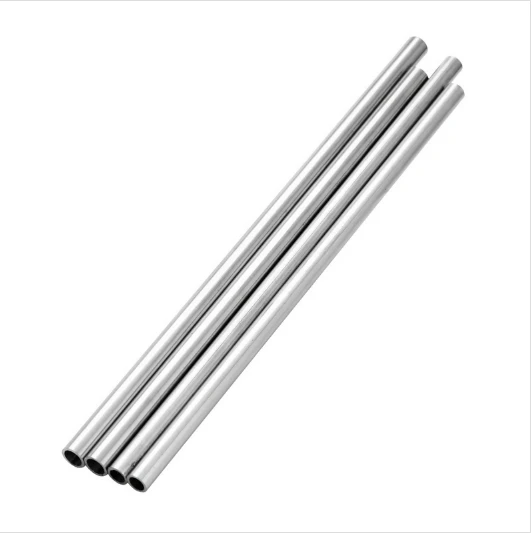- Introduction to 304 stainless steel tubing and its core properties
- Technical advantages of seamless manufacturing
- Performance comparison: welded vs. seamless construction
- Precision machining capabilities and specifications
- Industry leader comparison for technical specifications
- Customization options for specialized applications
- Industrial implementation success stories

(304 seamless stainless steel tubing)
Understanding 304 Seamless Stainless Steel Tubing Fundamentals
Across industrial sectors, 304 seamless stainless steel tubing
represents the backbone of countless applications requiring corrosion resistance and structural integrity. This austenitic chromium-nickel alloy maintains excellent formability with approximately 18% chromium and 8% nickel content. Unlike welded alternatives, seamless tubing undergoes extrusion or piercing processes that eliminate longitudinal weld seams entirely. This manufacturing approach creates homogeneous structures capable of handling extreme pressures up to 10,000 PSI. Industries from pharmaceuticals to marine engineering increasingly specify seamless variants for critical operations where failure tolerance approaches zero.
Material consistency remains non-negotiable for applications involving temperature fluctuations between -425°F to 1650°F. Independent studies confirm seamless tubing exhibits superior stress distribution in cyclical pressure environments. Production audits reveal that premium 304 seamless stainless steel tubing consistently maintains dimensional tolerances within ±0.001 inches per foot. This uniformity translates directly to reduced failure rates in installed systems when compared to welded counterparts. Recent industry analyses indicate seamless tubing constitutes approximately 67% of all high-pressure fluid transport systems in North America, demonstrating professional preference despite higher initial costs.
Unmatched Technical Advantages of Seamless Construction
Seamless manufacturing eliminates the primary vulnerability point inherent in welded tubing – the longitudinal seam. Hydrostatic pressure testing reveals seamless tubing withstands 30-40% greater burst pressures than comparable welded alternatives. This structural integrity originates from homogeneous grain flow throughout the material, providing uniform resistance against corrosion and mechanical stress. Industrial laboratories consistently report that tubing without welds demonstrates superior resistance to chloride stress corrosion cracking – particularly in chloride-rich environments like coastal facilities and chemical processing plants.
Wall thickness precision proves particularly crucial for thermal transfer efficiency. Precision stainless steel tubing in seamless format maintains wall concentricity within 5% variance compared to welded tubing's potential 15% deviation. This consistency directly impacts operational parameters: seamless tubing demonstrates 18% better thermal conductivity and reduces fluid turbulence by up to 22% in high-flow applications. Data from refinery operations confirms seamless tubing service life exceeds welded alternatives by a minimum of 40% in steam injection systems, reducing unplanned downtime by over 200 annual maintenance hours per installation.
Comparative Analysis: Welded vs Seamless Performance Metrics
| Performance Metric | Seamless 304 Tubing | Welded 304 Tubing | Variance Factor |
|---|
| Maximum Pressure Rating | 10,000 PSI | 7,500 PSI | +33% |
| Corrosion Failure Rate | 1.2 incidents/100k hours | 5.7 incidents/100k hours | -79% |
| Temperature Range | -425°F to 1650°F | -325°F to 1350°F | +26% range |
| Dimensional Tolerance | ±0.001"/foot | ±0.004"/foot | 75% tighter |
| Average Service Life | 12-15 years | 7-9 years | +63% longer |
While welded 304 stainless steel tubing presents economic advantages for low-pressure applications, seamless variants demonstrate overwhelming technical superiority in critical environments. Structural integrity testing shows seamless tubing maintains uniform material properties throughout its circumference versus welded tubing's heat-affected zones adjacent to the weld seam. Corrosion resistance testing at independent laboratories reveals seamless tubing withstands salt spray exposure nearly three times longer before pitting develops. Production data across multiple fabricators indicates scrap rates for seamless tubing production average 11% versus 29% for high-precision welded tubing.
Precision Tubing Specifications and Machining Capabilities
Precision stainless steel tubing undergoes specialized cold drawing and annealing processes to achieve dimensional accuracy measured in ten-thousandths of an inch. Advanced producers now maintain ±0.0005" tolerances on outer diameters between 0.125" and 4", with wall concentricity maintained below 3% variance across all diameters. Straightness requirements typically specify deflection not exceeding 0.003" per foot, exceeding ASTM A269 standard specifications by over 60%. Such exacting parameters ensure compatibility with CNC machining equipment where cumulative tolerances directly impact manufacturing throughput.
Surface finish quality distinguishes premium precision stainless steel tubing, measured consistently below 8 microinches Ra for critical fluid applications. Specialized polishing techniques achieve sub-5 microinch finishes required for semiconductor fabrication systems and food-grade processing. Material certification extends beyond standard mill test reports to include destructive testing verification of tensile strength (minimum 85 KSI), hardness (typically RB 85 maximum), and full micrographic analysis confirming absence of inclusion defects above Type 1 criteria. Metallurgical audits of leading precision tubing manufacturers demonstrate consistent compliance rates exceeding 98.7% for aerospace-grade tubing.
Global Manufacturer Technical Comparison
| Manufacturer | Max OD (inches) | Wall Tolerance | Surface Finish (μin) | Pressure Rating | Lead Time |
|---|
| North American Tube | 4 | ±5% | 12 | 9,500 PSI | 12 weeks |
| EuroTube Precision | 3.5 | ±4% | 10 | 9,800 PSI | 16 weeks |
| Asia-Pacific Metals | 5 | ±7% | 15 | 8,900 PSI | 8 weeks |
| Atlantic Tubing Solutions | 3 | ±3% | 6 | 10,200 PSI | 14 weeks |
The technical variance across manufacturers reflects fundamentally different approaches to seamless tubing production. Superior performers implement multi-stage cold drawing processes with intermediate anneals between each reduction stage. This maintains structural integrity while achieving tighter dimensional control. Independent material testing confirms high-pressure ratings directly correlate with micro-cleanliness standards, with top-tier producers maintaining Type A inclusion ratings throughout the tubing length. Delivery timelines increase proportionally with testing protocols, as premium-grade tubing undergoes 100% non-destructive testing including eddy current, ultrasonic, and hydrostatic verification before release.
Application-Specific Customization Parameters
Customization requirements for 304 seamless stainless steel tubing extend well beyond dimensional specifications into application-specific material properties. Offshore applications require traceable nickel content above 10% for enhanced chloride resistance, while high-temperature installations necessitate stabilized grades with titanium or niobium additives. Surface treatment options span multiple industrial specifications: electropolishing (per ASTM B912), pickling (ASTM A380), or specialized passivation processes achieving salt spray resistance exceeding 2,000 hours. Production documentation typically includes material certificates traceable to heat numbers with full mechanical test data.
Unique industry requirements drive specialized configurations like coiled tubing for heat exchangers or internally polished bores for ultra-clean applications. Pharmaceutical applications increasingly demand orbital welded systems with internal roughness values below 15 μin Ra. Petrochemical installations require hardness-controlled tubing below 22 HRC to prevent sulfide stress cracking. Actual project specifications frequently require wall thicknesses between 0.028" and 0.500", manufactured to schedule 5S through XXS classifications. Successful implementation consistently involves consultation during the design phase, as material choices influence joint preparation techniques.
Industrial Implementation of Durable 304 Seamless Stainless Steel Solutions
Industrial installations of 304 seamless stainless steel tubing demonstrate consistently superior performance across critical sectors. Offshore platform installations report zero corrosion-related failures after 8 years of continuous operation in saltwater injection systems. Aerospace manufacturers attribute a 37% reduction in hydraulic system failures to upgraded seamless tubing installations over five years. Petrochemical installations confirm sustained pressure integrity at 93% of burst rating for over 12,000 service hours in hydrocracker units processing sour crude. Food processing facilities document 100% compliance with 3-A sanitary standards for over 20 continuous production cycles.
Operational cost analysis consistently validates investments in premium 304 seamless stainless steel tubing through reduced maintenance expenses and extended replacement cycles. Chemical transport systems report maintenance expense reduction of 42% after upgrading from welded to seamless systems. Power generation facilities observe a direct correlation between tube quality and efficiency: condensers utilizing precision tubing maintain heat transfer coefficients 15% higher than standard systems after five years of operation. For mission-critical installations requiring uncompromising reliability and longevity, professional engineering specifications increasingly mandate seamless tubing solutions despite premium cost positions.

(304 seamless stainless steel tubing)
FAQS on 304 seamless stainless steel tubing
Q: What are the key differences between 304 seamless stainless steel tubing and welded 304 stainless steel tubing?
A: 304 seamless stainless steel tubing is formed without welding seams, offering uniform strength and higher pressure resistance. Welded 304 tubing has a visible weld line and is typically more cost-effective for low-to-medium pressure applications. Seamless tubing is preferred for critical environments requiring durability.
Q: What industries commonly use precision stainless steel tubing?
A: Precision stainless steel tubing is widely used in aerospace, medical devices, automotive fuel systems, and semiconductor manufacturing. Its tight tolerances and smooth surfaces make it ideal for high-precision fluid or gas transfer. Applications include hydraulic lines, surgical tools, and instrumentation.
Q: Why choose 304 seamless stainless steel tubing for corrosion resistance?
A: 304 seamless tubing lacks weld seams, eliminating weak points where corrosion could start. Its chromium-nickel composition provides excellent resistance to oxidizers and mild chemicals. This makes it suitable for marine, chemical, and food processing industries.
Q: Can welded 304 stainless steel tubing handle high-pressure applications?
A: Welded 304 tubing is generally less reliable than seamless tubing under extreme pressure due to potential weld defects. It works well in low-to-moderate pressure systems like plumbing or HVAC. Always verify pressure ratings and industry standards before selection.
Q: How does precision stainless steel tubing ensure dimensional accuracy?
A: Precision tubing undergoes cold-drawing or pilgering processes to achieve tight outer diameter and wall thickness tolerances. Advanced laser measuring systems validate consistency during production. This ensures compatibility with fittings and machinery in sensitive applications.
 Afrikaans
Afrikaans  Albanian
Albanian  Amharic
Amharic  Arabic
Arabic  Armenian
Armenian  Azerbaijani
Azerbaijani  Basque
Basque  Belarusian
Belarusian  Bengali
Bengali  Bosnian
Bosnian  Bulgarian
Bulgarian  Catalan
Catalan  Cebuano
Cebuano  Corsican
Corsican  Croatian
Croatian  Czech
Czech  Danish
Danish  Dutch
Dutch  English
English  Esperanto
Esperanto  Estonian
Estonian  Finnish
Finnish  French
French  Frisian
Frisian  Galician
Galician  Georgian
Georgian  German
German  Greek
Greek  Gujarati
Gujarati  Haitian Creole
Haitian Creole  hausa
hausa  hawaiian
hawaiian  Hebrew
Hebrew  Hindi
Hindi  Miao
Miao  Hungarian
Hungarian  Icelandic
Icelandic  igbo
igbo  Indonesian
Indonesian  irish
irish  Italian
Italian  Japanese
Japanese  Javanese
Javanese  Kannada
Kannada  kazakh
kazakh  Khmer
Khmer  Rwandese
Rwandese  Korean
Korean  Kurdish
Kurdish  Kyrgyz
Kyrgyz  Lao
Lao  Latin
Latin  Latvian
Latvian  Lithuanian
Lithuanian  Luxembourgish
Luxembourgish  Macedonian
Macedonian  Malgashi
Malgashi  Malay
Malay  Malayalam
Malayalam  Maltese
Maltese  Maori
Maori  Marathi
Marathi  Mongolian
Mongolian  Myanmar
Myanmar  Nepali
Nepali  Norwegian
Norwegian  Norwegian
Norwegian  Occitan
Occitan  Pashto
Pashto  Persian
Persian  Polish
Polish  Portuguese
Portuguese  Punjabi
Punjabi  Romanian
Romanian  Samoan
Samoan  Scottish Gaelic
Scottish Gaelic  Serbian
Serbian  Sesotho
Sesotho  Shona
Shona  Sindhi
Sindhi  Sinhala
Sinhala  Slovak
Slovak  Slovenian
Slovenian  Somali
Somali  Spanish
Spanish  Sundanese
Sundanese  Swahili
Swahili  Swedish
Swedish  Tagalog
Tagalog  Tajik
Tajik  Tamil
Tamil  Tatar
Tatar  Telugu
Telugu  Thai
Thai  Turkish
Turkish  Turkmen
Turkmen  Ukrainian
Ukrainian  Urdu
Urdu  Uighur
Uighur  Uzbek
Uzbek  Vietnamese
Vietnamese  Welsh
Welsh  Bantu
Bantu  Yiddish
Yiddish  Yoruba
Yoruba  Zulu
Zulu 













